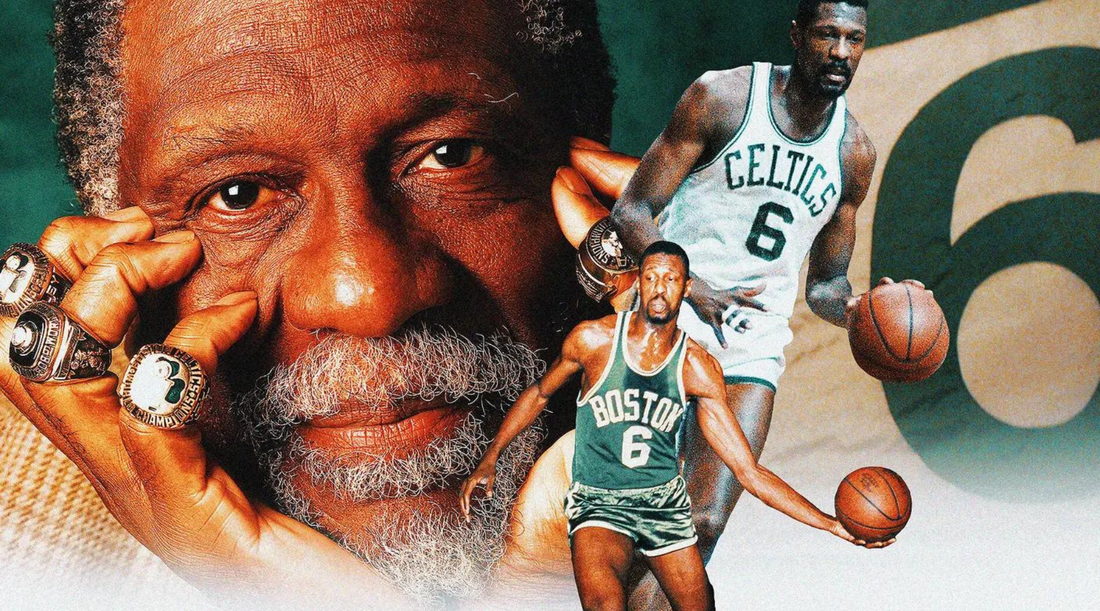Sports fans everywhere are currently enjoying what seems like a peak era for athletics. Athletes like Tom Brady and LeBron James are rewriting the book on what’s possible for aging athletes, and winning championships while doing it. However, back in the 1960’s, there was an athlete who wrote that book in the first place, and they did it on the court and from the sideline as well. Bill Russell, the legendary Boston Celtic, won an astounding 11 NBA championships during his playing career - and a few of those came while he was playing AND coaching the team. Russell was the first Black superstar in the NBA, and no discussion of the best team sport athletes ever is complete without mentioning the man whose friends called him “The Big Dipper.”
Despite eventually achieving what would seem to be predestined heights, Russell struggled to acclimate to basketball at first. He was cut from his junior high school team, and was almost cut as a freshman at McClymonds High School in Oakland, CA.
However, once he got the hang of it, there was no stopping him. His first true contributions to the game came on defense. Russell became an anomaly at the time, by… jumping. The prevailing wisdom was to stay on the ground as much as possible while defending, but Russell took advantage of this groundbreaking tactic to tune his shot-blocking abilities at a young age.
Russell was not highly recruited, garnering just one offer from the University of San Francisco. The recruiter, Hal DeJulio, even noted that Russell’s “atrocious fundamentals” were not particularly convincing. The head coach of USF’s team, Phil Woolpert, didn’t discriminate against players on the basketball court, which likely contributed to Russell’s recruitment to the school. It also meant that Russell started, along with two future stars in K.C. Jones and Hal Perry. Jones would play with Russell in the professional ranks as well, winning 11 championships in his time in Boston.
Russell was so dominant that the NCAA altered the dimensions of the court, to allow more space around the rim. This (ideally) would give opposing players more of a chance to score with Russell defending them. It didn’t. During his senior year, he had a game with 20 blocks, and John Wooden called Russell, “the greatest defensive man I’ve ever seen.” High praise from a coach many consider to be the greatest ever!
However, not everything in his college career was all success. Despite Woolpert’s more equitable ideas of where Black people fit in college basketball, the rest of the country was often not as enlightened (or motivated). Russell and his Black teammates were often the focus of racism on road trips, and Russell would admit that these experiences hardened him against abuse, and made him understand that he couldn’t place his hopes on others accepting him. This would color the rest of his career; particularly his time in Boston.
After some turmoil on the day of the 1956 draft, Russell was eventually brought to the Boston Celtics via a trade with the St. Louis Hawks. The 1956-57 season was just a glimpse of what would come for Russell’s Celtics. They finished the regular season with their best record since the team was formed, and earned an appearance in the NBA playoffs. Their playoff run ended with a dramatic, double overtime victory in a championship-clinching game against who else but the St. Louis Hawks.
While the Hawks would complete a revenge tour in the ‘57-’58 season, the 1958-59 season would begin an unprecedented run of success. Between 1958 and 1965, the Boston Celtics won 8 straight NBA titles with Russell at the helm. The 1959 season was particularly important, since another all-time big man, Wilt Chamberlain, made his professional debut that year. Chamberlain and Russell would be dueling forces in the NBA’s Eastern conference for almost a decade, with Chamberlain convincingly beating Russell in statistical categories, but with Russell beating Chamberlain to championships.

Russell’s incredible career would only continue to break barriers when, before the start of the 1966-67 season, Russell was named head coach of the Boston Celtics, while still being their main star on the court. Russell was the first Black head coach of any NBA team, and became the first Black coach to win an NBA championship when his Celtics beat the LA Lakers in the 1968 NBA finals. That title was also Russell’s 10th in 12 years. His winning mentality shows in his career numbers. Russell averaged 15 points and 22.5 rebounds per game in the regular season, but those numbers jumped to 16 points and nearly 25 rebounds in the playoffs.
After another victory over the Lakers in the ‘69 Finals, Russell, who had a complicated relationship with the media and fame, simply retired with little warning given to the Celtics organization. Russell would not attend the victory parade for his 11th title, nor the ceremony for his induction into the Naismith Memorial Basketball hall of fame
This prickly demeanor that Russell wore publicly was the result of years of racist abuse he endured throughout college and his time as a professional player. During his career, Russell gained notoriety for his icy interactions with the press, and his refusal to sign autographs for fans. Russell felt that people who would support segregation and then cheer him on as a player were hypocritical and disingenuous. Russell was an active member of the Civil Rights Movement, and continued being an outspoken voice for racial and social justice until his death.
This, and Russell’s on-court achievements, contributed to his number 6 being the first number to be retired across the NBA, at the start of the 2022-23 season. The Boston Celtics will also hosted two commemorative games in honor of Russell during that season. In these ways, the man for whom the NBA Finals MVP trophy is named will continue to be a part of basketball and cultural history for years to come.
